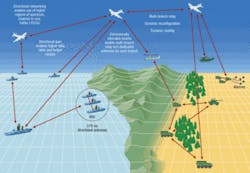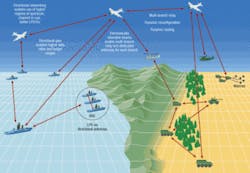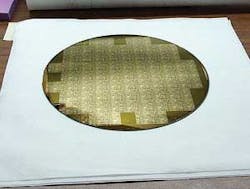RF and microwave technology enable networking on the move
Designers of RF and microwave technology say low power and small size remain the trend in product designs. Meanwhile, integrators adapt and combine RF and microwave technologies to enable networking on the move.
By John McHale
Military and aerospace systems integrators that buy radio-frequency (RF) and microwave components are demanding low power, ever-smaller sizes, and increasing integration of components into products with several functions.
RF, in this industry’s context, refers to radio frequencies lower than 1 GHz, and microwave refers to radio frequencies from 1 to 300 GHz.
These are the typical trends of today’s RF and microwave designs, says Rick Folio, director of research and development at the Harris Corp. Government Communications Systems Division in Melbourne Fla. Harris customers want to improve performance while saving money; one way to do that is through power efficiency, he says.
They also want to move toward higher frequencies in the spectrum because the lower frequencies are mostly occupied.
“We’re finding business in the transformational efforts of the Department of Defense (DOD) such as the Future Combat Systems program,” says Bill Graves, chief technology officer, TRAK Microwave Corp. in Tampa, Fla.
What these customers increasingly want is integrated functionality, Graves says, and they want it in a smaller, lighter package for electronic warfare applications. In most cases, he says, this involves combining the functions of different products into one solution. The company has much of the ability to do this in-house but has added expertise in the areas of millimeter wave and radio.
TRAK offers a C-Band five-channel switched-filter assembly used in airborne defense applications. The switch filter features an ultraminiature, low-profile design with less than 10-dB pass-band insertion loss and 60-dB typical stop-band rejection at plus-or-minus 500 MHz.
The model SWF002 has high-speed switching at less than 100 nanoseconds, is hermitically sealed, and laser welded with a better than 350,000 hours mean time between failures. The switch filter meets quality assurance provisions of Class H hybrid equivalent, TRAC officials say.
Advanced EHF
Harris engineers are using their microwave technology satellites in the U.S. Air Force’s next-generation Advanced Extremely High Frequency (EHF) satellite communications (SATCOM) terminal.
Once fielded, the ship-, submarine-, and shore-based terminals will link with Advanced EHF satellites to provide the U.S. Navy with improved command, control, and communications capabilities.
Harris also participated in the Navy’s AN/WSC-6(V)9 Multi-band Shipboard SATCOM Terminal (MSSCT) program. Harris will develop four Advanced EHF terminal prototypes.
The Advanced EHF satellite program is a follow-on to the DOD’s Milstar communications satellite system. When operational, the Advanced EHF constellation will consist of four cross-linked satellites. The U.S. Navy’s Advanced EHF terminals will enable its afloat and shore units to communicate from anywhere in the world via the Air Force satellites, as well as other military and commercial satellites simultaneously.
The multiband, multimode terminals will provide deployed Navy commanders with secure command-and-control capability, as well as enhanced communications such as tactical data and imagery, real-time video, battlefield maps, and targeting information
Harris is also providing phased-array antennas for the DDX, the Navy’s next-generation land-attack destroyer.
Gallium nitride
Engineers at BAE Systems Information & Electronic Warfare Systems (IEWS) in Nashua, N.H., are developing gallium nitride (GaN) components to improve power efficiency and chip performance under the Wide Bandgap Semiconductor Technology initiative from the U.S. Defense Advanced Research Projects Agency (DARPA) in Arlington, Va.
Gallium nitride high-electron mobility-transistor (HEMT) devices provide the relatively high power density and efficiency necessary for high-power phased array radar, electronic warfare, missile seekers, and communications systems. TriQuint Semiconductor Inc. in Hillsboro, Ore., leads the BAE Systems team. The Army Research Laboratory in Adelphi, Md., is the contracting activity.
The program seeks to develop new materials, devices, and properties of wide-bandgap semiconductors for RF applications, DARPA officials say. The program has several specific goals:
- Greater than 100-millimeter semi-insulating, high-quality substrates (Phase I)
- Epitaxial material technologies with better than 1 percent composition, thickness, and doping control (Phase I)
- Robust RF/analog devices (Phase II)
- Microwave and mm-wave circuit demonstrations (3 to 35 GHz) (Phase III)
- High-power electronic integration assemblies (Phase III).
Gallium nitride substrates in a power amplifier enables higher power at a higher frequency, says John Windyka director of Advanced Microwave Devices at BAE Systems in Nashua, N.H. It improves power efficiency by a factor of 10, says Dr. Phil Smith, director of Microwave Devices & Circuits and an Engineering Fellow for BAE Systems.
Gallium nitride has better thermal properties than does gallium arsenide substrates, Smith says. The other teams working on the Wide Bandgap program are Raytheon and Northrop Grumman, Smith says. “Our contribution is the wideband amplifier development,” Smith says.
Another program where BAE engineers are lowering power and price is the Metamorphic High Electron Mobile Transistor, Smith says. It uses indium phosphide on a gallium arsenide (GaAs) substrate, Smith says.
The superior high-frequency properties of InP HEMTs result from the favorable transport properties of electrons in InGaAs channels with high indium content. HEMT with a record 562 GHz, while reported InP HEMT with values of 600 GHz, remains the highest of any nontransferred substrate device, Smith says. “Applications for which InP HEMT technology is well-suited include high-speed digital circuits, lightwave communication ICs, and a wide range of microwave amplifiers requiring low noise, high efficiency, low DC power consumption, low-voltage (battery-powered) operation, or operation at very high frequencies.
“Despite their unequalled performance, widespread use of InP HEMTs has been hindered by properties of the InP substrate upon which the devices have historically been grown due to lattice matching considerations,” he continues. “As compared to GaAs, these include the limited availability of large (6-inch) InP substrates, their inherent fragility, and the increased difficulty of etching through-substrate via holes. MHEMT is one rapidly emerging solution to the issue of InP HEMT manufacturability, employing a special buffer layer that effects a significant shift (typically up to 5 percent) in lattice constant, thereby allowing InP HEMT device structures with high indium content InGaAs channels to be realized directly on GaAs substrates.”
The technology also can scale to large wafer sizes and the price does not go up because the cost per die remains the same regardless of wafer size, Smith says.
BAE Systems also won a contract for the TEAM (Technology for Efficient, Agile Mixed Signal Microsystems) program, which seeks to take advantage of the affordability of silicon to develop low-cost systems-on-a-chip (SoC) that integrate RF and digital circuits onto one semiconductor device. Until now, separate RF and digital circuits have been linked by mixed-signal components like A-D and D-A converters. This multichip approach has limited speed, performance, and system flexibility. TEAM will provide an integrated solution that will link the RF and digital processing chain on a low-cost chip.
“In addition to reducing the overall size of the package, the SoC approach reduces power requirements, and eliminates performance degradation associated with interchip wiring,” says Frank Stroili, BAE Systems TEAM Program Manager. “Furthermore, the single fabrication process provides a substantially lower overall cost.”
Another program in this space in which BAE Systems is participating is TFAST (Technology for Frequency Agile Digitally Synthesized Transmitters), which is to develop indium phosphide (InP) heterojunction bipolar transistor (HBT) technology to reach levels of micro-circuit performance significantly ahead of anything available today, including a fivefold reduction in power consumption. Higher performance at lower power, in more highly integrated packages, can benefit any defense communications system with challenging weight or power requirements.
“This is the device building-block program for future RF systems,” says Tony Immorlica, BAE Systems business development manager. “The TFAST technology will have a direct, high impact on current and future DOD programs. Electronic warfare (EW) systems are particularly suitable for TFAST,” he added, because “its digital generation and direct sampling of RF signals would greatly enhance future EW capabilities.”
BAE Systems is also involved in the upgrades of F/A-22 and Joint Strike Fighter (JSF) digital receivers, new electronic attack pursuits, mission electronics, defensive avionics, radar warning receivers, and space mission payloads.
Research funding
Many defense electronics designers prefer a climate that revolves around a threat of war rather than actual participation in one. They believe more money for new technology and research and development is available in the presence of a threat, but not during a conflict when government money goes for boots, bullets, and gas.
Harris’ Folio says the RF and microwave funding at least for his company is steady through both climates. “We are involved in a stable base of programs that are not affected by the needs of boost and bullets,” he says. “It is less cyclical than other areas, Folio adds.
Programs such as Advanced EHF do not typically get cut during times of war.
Asian migration
Funding for military semiconductor technology is getting examined more closely as there is a growing fear in U.S. defense circles that U.S. semiconductor technology could migrate to Asia, or more specifically, China, says Smith of BAE Systems.
“The handwriting is on the wall,” he says. Technology is already in Taiwan and it could migrate to China by subterfuge or by force. Right now only three prime contractors have foundries for 3.5-micron semiconductor technology-BAE Systems, Raytheon, and Northrop Grumman, Smith says.
There is a possibility that the government may step in with major funding the way it did for the radiation-hardened foundries of BAE Systems-Manassas and Honeywell in Plymouth, Minn., Smith adds.
A recent Defense Science Board report covered this in detail, Smith says. “The emphasis is on silicon but the same concerns apply to microwave IC technologies such as GaAs, InP, and GaN.”
Smith referred to an article in Manufacturing News by Richard McCormack, “Developing A Strategy For Saving High-Tech: Defense Science Board Wrestles A Political Hot Potato.”
The article states, “In the semiconductor field, DOD is funding a stopgap measure to assure a continued supply of military specific microprocessors. In a quiet manner, it is providing $60 million a year to a dedicated ‘trusted foundry’ operated by IBM in Vermont. Suppliers in the industry believe a far more comprehensive strategy is required for the military to secure state-of-the-art semiconductors from U.S companies. DOD and the federal government have substantially reduced funding for research in advanced semiconductor production techniques, they point out.”
AeroComm’s releases AC4790 transceivers that boost range
Officials at AeroComm in Lenexa, Kan., are offering peer-to-peer transceivers that remove the server from an RF communication system, facilitating expandable mesh networking.
The wireless solution complements AeroComm’s server-client based AC4490 transceivers, giving any user the flexibility to choose the protocol that best suits the application
The AC4790’s protocol supports independent communication between any two in-range transceivers in an RF network. Each transceiver “node” knows exactly which other nodes are within talking distance, as well as the signal strength of each one, AeroComm officials say. The original equipment manufacturer (OEM) is able to design routing sequences that optimize the network without bogging down system performance.
“Both flexibility and reliability are vital to a vast array of network architectures,” says Mike Varady, chief executive officer of AeroComm. “In AC4790’s intelligent addressing mechanism, we embed software ‘hooks’ so an OEM can have complete control of the routing schemes. This maximizes the efficiency of the network, while allowing the OEM to alter the architecture as necessary.”
Several node groups may also communicate simultaneously, supporting system scalability. Traffic is forwarded from node to node, across a broad range. An optional API command processor controls packet delivery and acknowledgment (on a packet-by-packet basis) and reports to the host device, reducing OEM software development. Additionally, AC4790s feature industry-leading 25‑ms sync times and SenseAdjust-a software-controlled RF desensitizer that wards off interference.
The AC4790 family utilizes FHSS technology, employs data-encryption standards and supports transmit-power levels of up to one watt, providing for long range between nodes.
For more information visit www.aerocomm.com.
Peregrine offers anti-jamming device
Engineers at Peregrine Semiconductor in San Diego have developed an anti-jamming device for global positioning.
Jamming resistance typically comes at an extreme premium, and standard commercial chipsets lack inherent jamming resistance altogether. Peregrine Semiconductor now offers the PE8510x integrated global positioning dual-band receiver core for industrial, military and space applications.
The solution has optimal amplitude and phase matching between receivers. Digital implementation of the AGC loop provides very accurate control and signal level reporting without calibration tables. Further, the on-chip digital control loop does not require external loop capacitors, nor A/D or D/A conversions, and allows precise control of the bandwidth and hysteretic. Operation of this loop can be dynamically programmed through the base band digital interface.
The PE8510x dual-band receiver offers monolithic integration of several receivers from antenna in through processed bits out.
Additional features include custom integer and fractional-N synthesizers with high comparison frequencies for low integrated phase noise; integrated A/D converters and Filters; support of external A/D converters; a reference oscillator with external crystal; and internal reference doubler. This high level of integration results in a dramatic reduction in supporting components and PCB area. First generation PE8510x devices are offered in ceramic or plastic packaging, including the 169-pin 11 x 11-mm BGA package with 0.8-mm ball pitch.
Applications include rad-hard implementation for satellites, and military needs in telemetry, munitions, personnel, and equipment tracking. For more information go online at www.psemi.com.
Networking on the move
Imagine an individual soldier, tank, or airplane functioning as its own ground station, seamlessly linking to other assets on a battlefield and creating a truly networked force.
Engineers at the Harris Corp. Government Communications Systems Division in Melbourne, Fla., are developing such concepts using the benefits of RF technology and microwave devices. The program is Mobile Ad-Hoc Networking Technology (MANET) Field Testing, which Harris demonstrated last year.
MANET techniques are crucial for communications among military platforms such as ships, aircraft, and ground vehicles as they operate on the move without fixed infrastructure, Harris officials say.
Much of the focus during the demonstrations involved testing user applications operating over the MANET topology. Demonstrated were voice over Internet Protocol (VoIP) conferencing, streaming video, collaborative planning, e-mail messaging, and location data reporting. Other testing focused on network self-organization and self-healing as nodes enter and exit the network; link recovery from failures due to terrain-induced blockage; frequency reuse to improve bandwidth; and adaptive channel capacity management to dynamically meet changes in node traffic.
The Harris-developed communications waveform helped schedule seamless link connections adaptively between several nodes operating in a mobile ad-hoc network. The waveform enables directional antennas to form an on-the-move mesh network topology to meet traffic demands of the battlespace of the future. The field demonstration tested 15 network nodes, 14 mobile nodes, and one fixed node, to measure network performance while moving and amid link blockages from buildings and dense foliage. The intent was to measure the system’s ability to adapt dynamically.
“Untethering military commanders from their static command-and-control platforms of the past by providing them with robust and dynamically adaptable communications on-the-move capabilities is essential to the fundamental tenets of net-centric warfare,” says Rick Folio, director of research and development at Harris. The MANET program is a big part of the “transformational communications initiatives of the Department of Defense,” he adds.
“It’s about improving the capabilities to the warfighter, Folio says. Harris will use phased array antennas in that space as well as software-defined radio technology, Folio says. Harris is one of the major players in the Joint Tactical Radio System, which is a software-defined radio. Harris’s Falcon II tactical radio products are being used for this program.
Under a three-year contract with the U.S. Naval Research Laboratory (NRL) sponsored by the Office of Naval Research (ONR), Harris developed technologies for controlling a network of mobile nodes using directional antennas.
MEMS-based technologies will meet future RF requirements
NATICK, Mass.-The global market for electromechanical (EMR) and solid-state (SSR) relays is expected to reach $4.2 billion by 2007, according to a study published by Venture Development Corp. (VDC) in late 2004.
RF relays and switches are expected to grow 10-15 percent annually due to an increased demand for higher switching frequencies in ATE, military, and telecommunication markets. These market and application segments require higher performance, but are less sensitive to price, VDC researchers say. In fact, some original equipment manufacturers (OEMs) would be willing to pay twice what they currently pay for better isolation, linearity, and insertion loss characteristics.
High-performance requirements, as well as price, power consumption, and packaging, are examples of important selection criteria that will drive future adoption of MEMS-based switch technologies in RF applications.
Regarding price, OEMs are willing to pay two times more for better performance characteristics. Within high-end commercial equipment and instrumentation markets, isolation, insertion loss, and linearity are important. New technologies, such as MEMS-based switches will likely displace high-performance pin diodes and GaAs FETs that are used.
OEMs are also hoping to reduce total power requirements for their systems by 50 percent. Instrumentation and wireless applications have the greatest need for low power components, VDC analysts say. Commercial and military market segments that use mobile devices for communication, test, and measurement will continue to demand low power in devices that require batteries with lower weight and bulk.
Miniaturization will benefit telecommunication and ATE market segments. Many embedded applications continuously attempt to reduce the size of computing and communication boards. This higher level of integration requires smaller component sizes and simpler designs.
According to Rick Barnard, practice director at VDC, “MEMS-based switches provide higher performance over alternative switching technologies, which will meet the growing need for improved isolation, linearity, and insertion loss characteristics in high-end RF/Microwave switching applications. Many manufacturers are targeting the huge wireless phone market, which is moving to 3G networks and multi-band switching technologies. However, near-term opportunities exist in ATE and high-end commercial and military instrumentation markets where price is less important. As demand increases, manufacturing and distribution channels will meet new and emerging market opportunities. This will enable prices to decline and will open the door to more price-sensitive consumer markets.”
For more on the report please visit www.vdc-corp.com/components/reports/04/br04-07.html.


